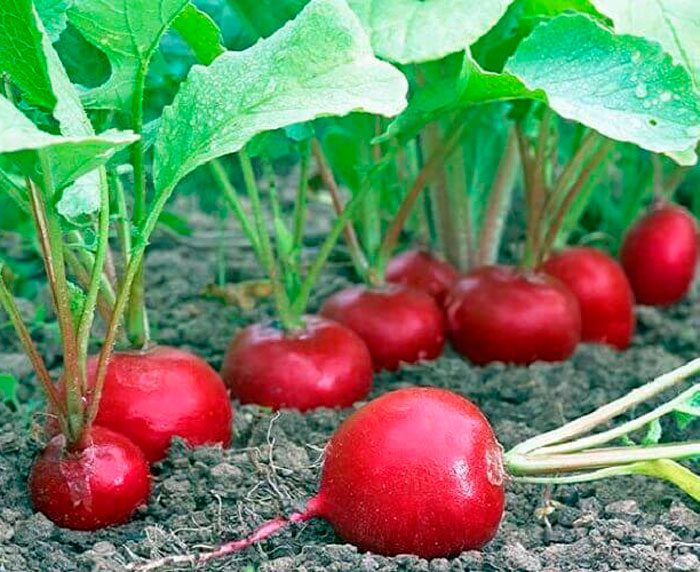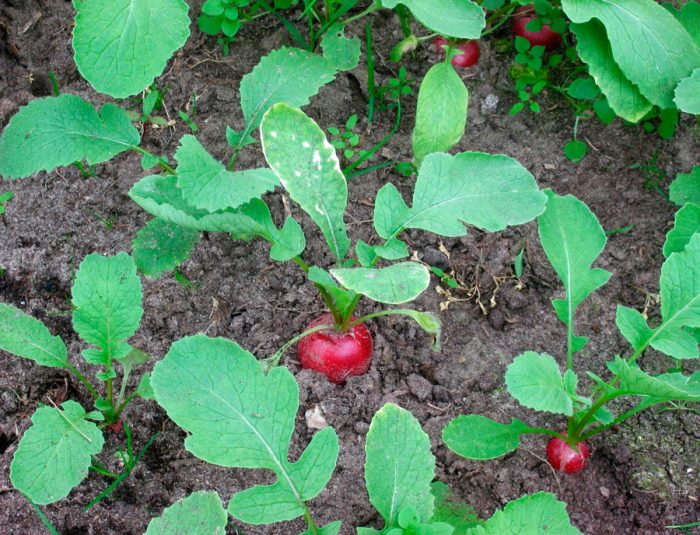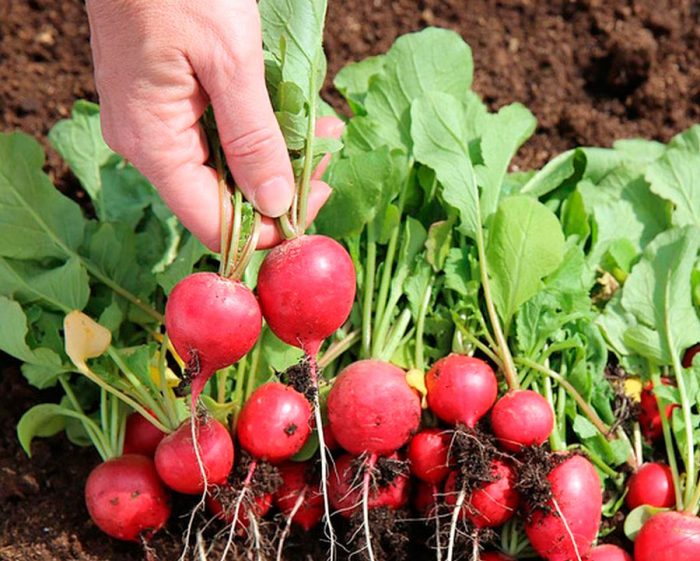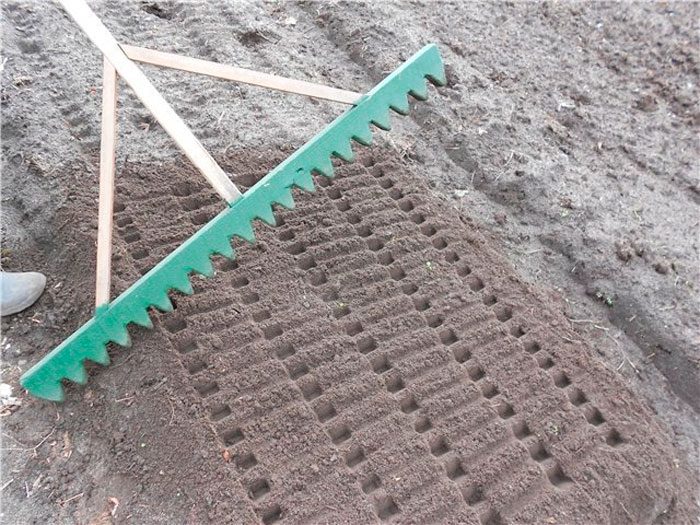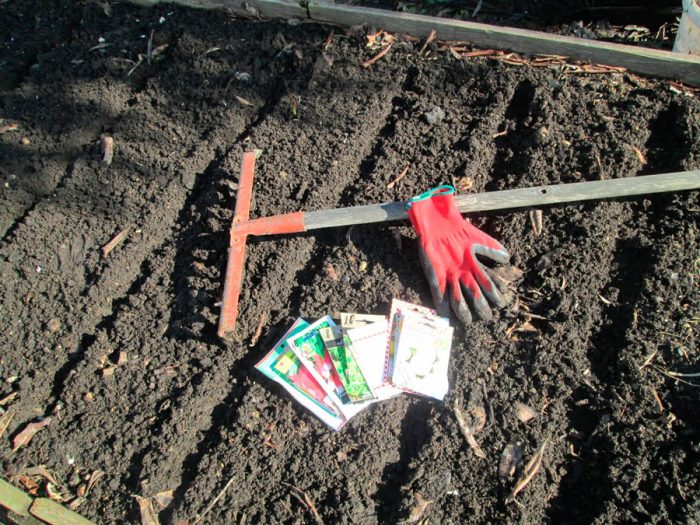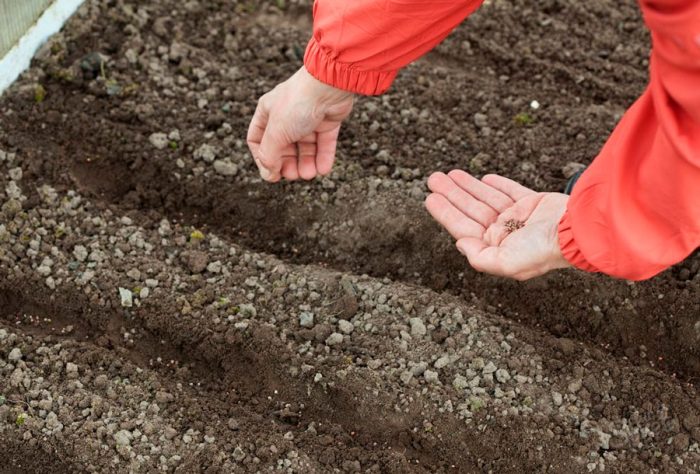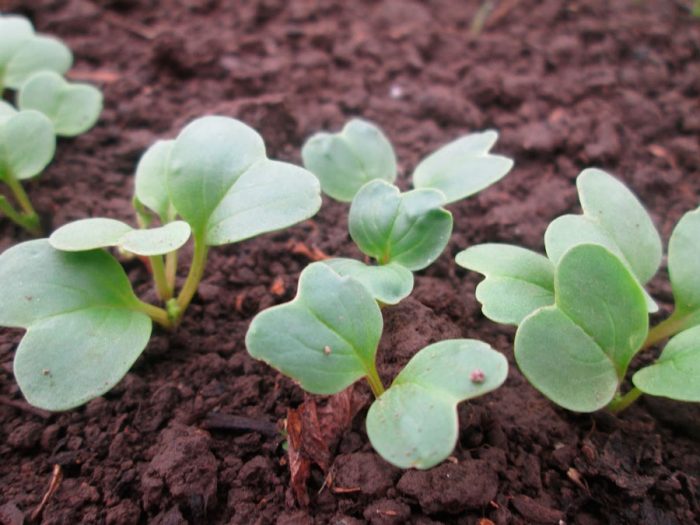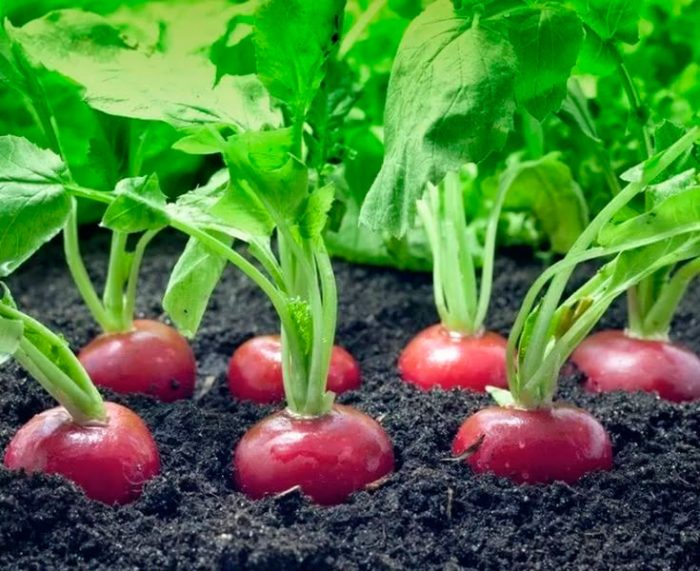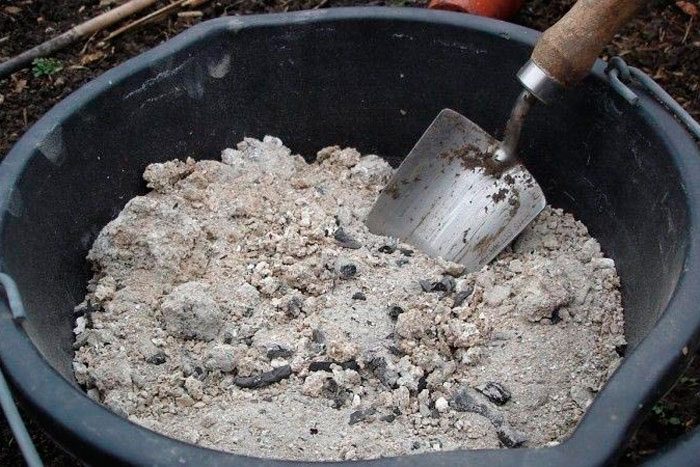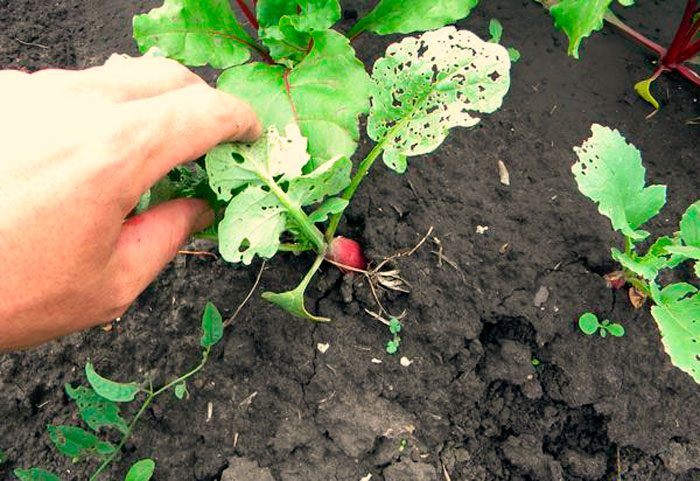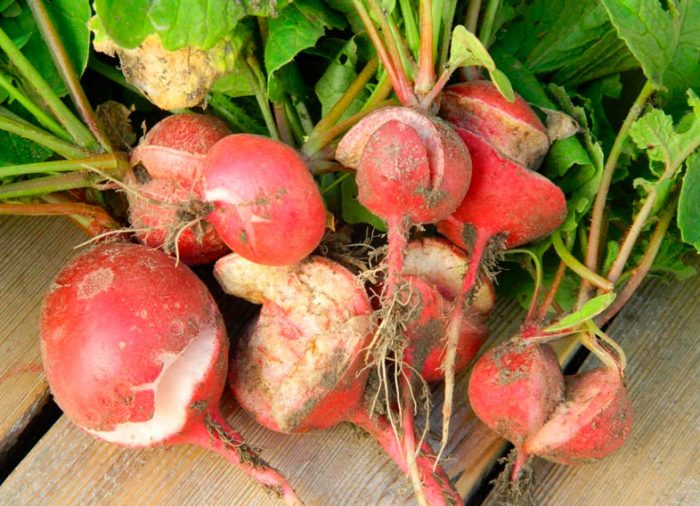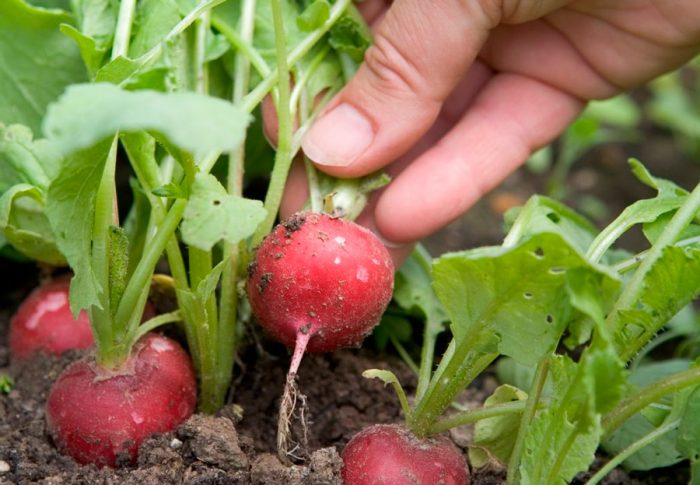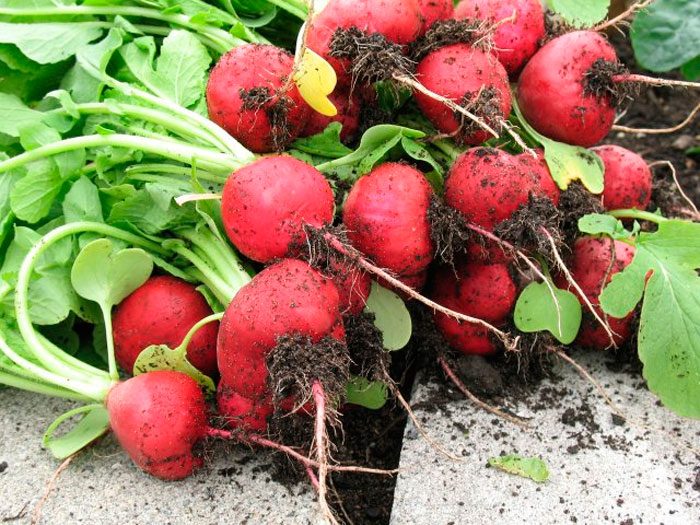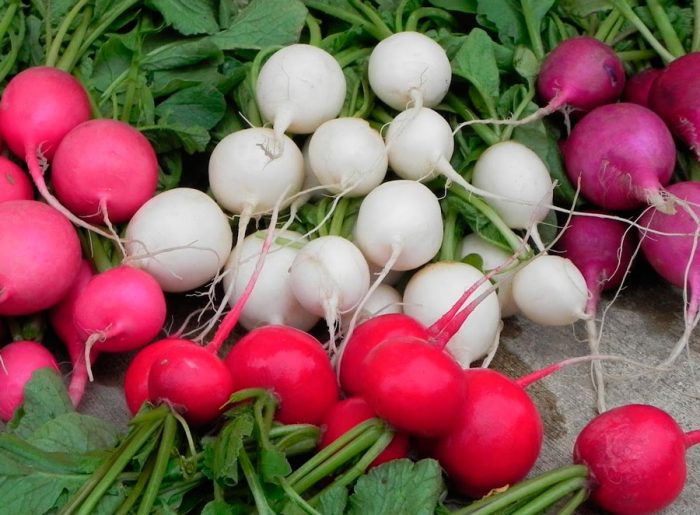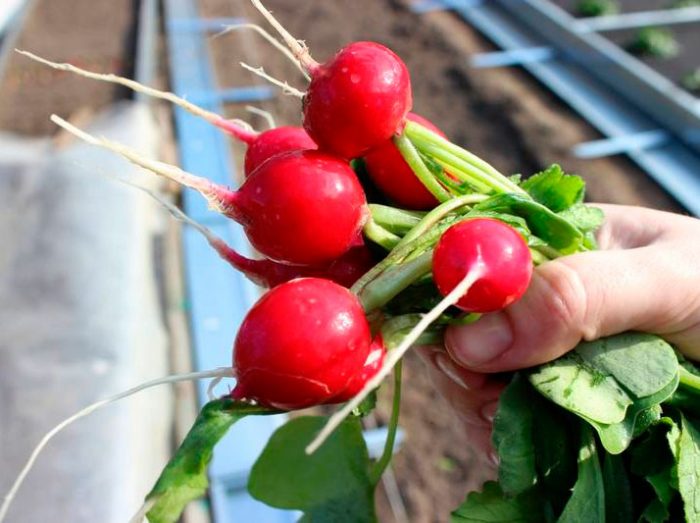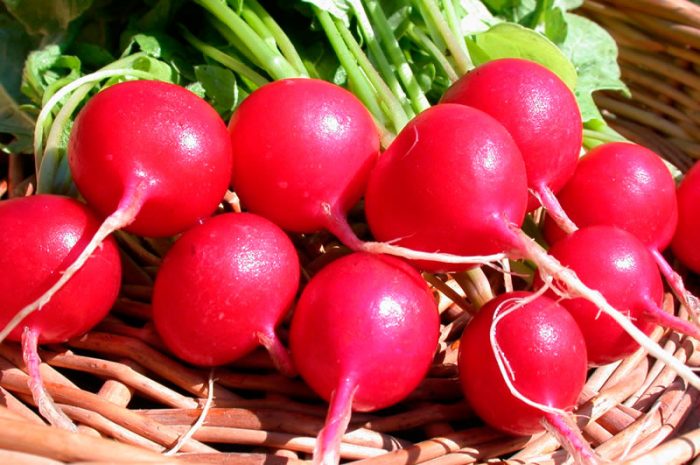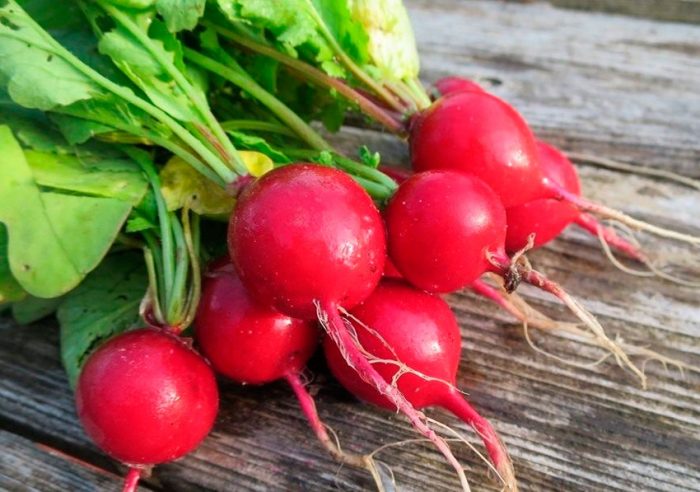The radish plant (Raphanus sativus) can be an annual or a biennial, it belongs to the Radish group of the genus Radish of the Cruciferous family (Cabbage). The name "radish" is derived from the Latin word "radix", which translates as "root". This early ripening plant is the leader among all fast growing vegetable crops. Radish is quite popular in spring, since at this time only it contains a large amount of live vitamins, which are very necessary for the body after the end of the winter period.
Content
Brief description of cultivation
- Sowing... Seeds are sown in open soil before winter or in spring from the last days of March to the second half of April.
- Illumination... The site must be well lit.
- Priming... You need a light and loose soil, neutral or slightly alkaline (pH 5.5-7.0).
- Predecessors... Cucumbers, potatoes, and legumes are good ones. The bad ones are representatives of the Cruciferous family. The area after the radish is suitable for planting tomatoes.
- Watering... Water often and abundantly. If it rains regularly in spring, then the bushes should be watered once a day in the morning or after 5 pm. In hot and dry periods, they should be watered twice a day in the morning and evening. The soil in the bed should be constantly slightly damp.
- Fertilizer... If the soil is poor, then you will need to feed the radish 2 times, and if it is fertile, then 1. For this, use a complex mineral fertilizer.
- Reproduction methods... Seeds.
- Harmful insects... Bears and cruciferous fleas.
- Diseases... Keela, bacteriosis and black leg.
Features of radish
Radish is a very popular vegetable crop in a large number of countries. Such a plant is a root vegetable that can reach 25 mm in diameter or more; it is covered with a thin skin painted pink, red or pinkish-white. It has a spicy taste because it contains mustard oil.
Such a culture needs a long daylight hours so that the root crop develops within the normal range, its duration should be about 13 hours. The growing season is very short, in this regard, you can grow radishes on your site, if desired, throughout the season, while sowing it regularly once a week.
Planting radishes in open ground
What time to plant
Germination of radish seeds begins already at a temperature of 1 to 2 degrees. In order for the bushes to develop within normal limits, they need a temperature of 15 to 18 degrees, but if it is hotter, then with a lack of light (at this time of the year the daylight hours are still short), the tops will begin to actively grow, while the root crop will be rough, and its growth will stop completely ...
Sowing radishes is carried out immediately after the soil has thawed and warmed up well. As a rule, this time falls in mid-April, however, in regions with a warm climate, early varieties can be sown in the last days of March.
Priming
Before you start sowing, you need to prepare the soil. A suitable area should be well lit (at least in the first half of the day), and also have reliable protection from gusts of wind. Light and loose soil, neutral or slightly acidic (pH 5.5-7.0), is best suited for growing. If the soil is excessively acidic, then it must be lime before sowing radish.
If there is such an opportunity, then it is recommended to sow radish in the area that will then be used for growing tomatoes. To do this, sowing can be done 1 time in 7 days until the twenties of May, while it will be possible to get a decent harvest of root crops, and at the same time prepare a plot for tomatoes. If the soil is heavy and cold or poor sandy loam, then before sowing such a culture it is necessary to dig it up with the introduction of humus (for 1 square meter of the site from 2 to 3 kilograms). It should be remembered that fresh manure is prohibited to use.
Such a root vegetable grows well in those areas where cucumbers, beans, potatoes or tomatoes were previously grown. A bad predecessor of this culture is turnips, radishes, turnips, daikon, watercress, cabbage and horseradish. Experts advise sowing radishes every year in a new place, while you need to try to ensure that each time it has predecessors from different families.
If the sowing of seeds will be carried out in the spring, then the preparation of the site must be done in the autumn. To do this, the site is digged to the depth of the shovel bayonet with the simultaneous introduction of humus or compost into the soil. Then, in the spring, right before sowing radishes, the site will need to be dug to a depth of no more than 20 centimeters with the simultaneous introduction of potassium-phosphorus fertilizer into the soil.
Sowing rules
Radish seeds are sown quite thickly, burying them into the soil by 20 mm; for this, grooves are made in advance and spilled with water. Row spacing should be between 15 and 20 centimeters. The grooves must be filled with loose soil, after which its surface is tamped. It is not necessary to water the crops; instead, it is recommended to cover the surface of the garden bed with a two-centimeter layer of humus or peat.
Before the first seedlings appear, at night (from 5 pm to morning) the surface of the garden bed must be covered with a film. Weather conditions have a great influence on the appearance of seedlings. If the weather is sunny and dry, then seed germination can begin on the third or fourth day after sowing. During the formation of the first true leaf plate, thinning of the plants should be carried out, while a distance of 30 to 50 mm should be left between them. If there is a desire, the sowing of seeds can be carried out by immediately placing them at a specified distance, thanks to this it will be possible to avoid thinning, because during the breakthrough of the seedlings, the roots of the remaining plants can be injured, as a result of which their development will deteriorate, which can lead to shooting.
If you take care of the radish correctly, then from the moment the seedlings appear until the harvest, it will take only 20 to 30 days.
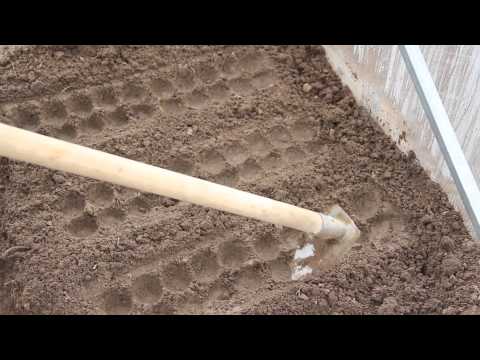

Watch this video on YouTube
Planting radishes before winter
Podzimny sowing of radish is carried out in the last weeks of autumn. Sowing of seeds begins after the first frost, and this time falls approximately in the second half of November. Not all varieties of such a crop can be used for sowing before winter.However, the Yubileiny, Spartak, Mercado, Mayak and Carmen varieties are excellent for this, as they can germinate even at low temperatures.
The plot for winter sowing is prepared in the last summer weeks. To do this, you need to dig up the soil, into which you should add 1 tbsp. l. potassium sulfate and double superphosphate, as well as half a bucket of rotted compost or humus per 1 square meter. The prepared bed from above must be covered with a film, while at the edges it is fixed with bricks or stones.
Sowing seeds in autumn is carried out in dry soil, after planting the seeds, the surface of the site is covered with a layer of mulch (peat or dry soil). Then the surface is tamped, and if snow falls, then they throw in a bed. The advantage of such sowing is that in spring it will be possible to get an earlier harvest. As a rule, it is harvested half a month earlier than when sown in spring.


Watch this video on YouTube
Radish care
When grown in open soil, radishes should be regularly watered, weeded and loosened between the rows. To facilitate the care of such a crop, the surface of the beds after sowing must be covered with a layer of mulch.
How to water
Radish is hygrophilous. In order for the bushes to develop normally, the optimum soil moisture should be about 80 percent. In this regard, watering the garden should be very frequent, especially at first, otherwise the taste of the roots will be bitter. If the bushes do not have enough water, then because of this, their shooting begins and the development of root crops stops. If you water the garden too abundantly or very often, this will lead to cracking of the root crops.
How to water radishes correctly? If it rains regularly in spring, then you need to water the garden every day in the morning or in the evening after 5 o'clock. In arid spring, water such a crop every day 2 times a day (in the morning and evening). It is especially necessary to monitor soil moisture especially after the seedlings have formed the first true leaf plate. In order for the roots to be juicy and tasty, it is necessary that the surface of the garden be slightly damp all the time.
Fertilizing radish
If the culture is grown on poor soil, then during the growing season it will need to be fed 2 times. When growing radishes on fertile soil, it will need to be fertilized only once. Try not to introduce a large amount of nitrogen into the soil, as this will cause intensive tops to grow, and the roots will become elongated, and they will contain a large amount of nitrates.
What fertilizers are best used so that harmful substances do not accumulate in root crops? The best for this is a nutrient mixture consisting of humus or compost, which is taken in the amount necessary for the soil in your area, as well as 10-15 grams of saltpeter, 10 grams of superphosphate, 0.5 liters of wood ash and 10 grams of potassium fertilizer. Thanks to this composition, you can get juicy, tasty and healthy roots. If the soil at the site is saturated with nutrients, then only mineral fertilizers are added to it.
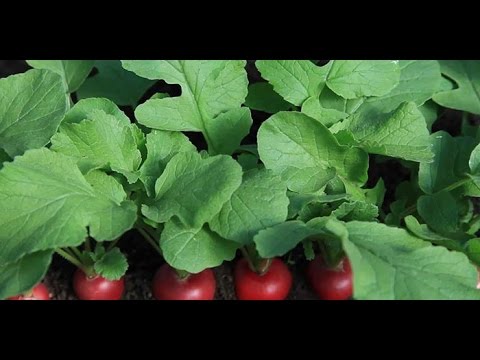

Watch this video on YouTube
Diseases and pests of radish
Pests
The greatest danger to radish is posed by such pests as bear and cruciferous flea. Other harmful insects do not have time to harm such a vegetable crop, as it grows very quickly. At an early stage of radish development, the cruciferous flea is the most dangerous for plants. The fact is that in just a few days it is capable of exterminating still very weak seedlings that have recently appeared. This pest does not pose a great threat to strengthened seedlings. What to use to treat crops to protect them from cruciferous flea beetles? In order to prevent such a pest from reaching delicate seedlings, they must be treated with a solution consisting of 1 bucket of water, 2 tbsp. fresh wood ash and 50 grams of laundry soap, which must be grinded.If desired, the ash can be simply spread evenly over the surface of the bed. However, it should be borne in mind that both the first and second methods are of low efficiency. And in order for the radish to be reliably protected from such a pest, it is necessary to build a shelter for it, for this, arched metal supports must be installed along the length of the entire bed, and spunbond must be put on top of them. This shelter allows the seedlings to breathe quite normally, the above-ground part of the bushes does not burn out under the scorching sunlight, and it also reliably protects against such a pest. When the seedlings get stronger and the tops grow up, the shelter must be removed.
Most often, bears damage early-ripening radish varieties that are grown in a greenhouse, where they climb in the spring to warm up. When growing such a crop in open soil, such a pest is unlikely to be able to do much harm to it. Getting rid of the bear is very difficult.
Diseases
For such a culture, the greatest danger is bacteriosis, in the affected bushes, the leaf plates turn yellow ahead of time, and the roots become mucus and begin to rot. If the bushes get sick with keel, then their foliage will also turn yellow, and swellings and growths form on the root crops. Seedlings can be affected by a black leg, in diseased plants, the foliage turns yellow and curls, and the stems at the base turn black.
For prevention purposes, experts advise choosing varieties that are resistant to such diseases, and you also need to strictly adhere to the rules of agricultural technology of this culture, and do not forget to pull out and destroy diseased specimens in a timely manner. To get rid of the keel, the soil around the bushes should be treated with milk of lime (for 1 bucket of water, 2 tablespoons of fluffy lime are taken), for 1 bush you need to take 1 liter of a similar mixture. Seedlings diseased with a black leg will need to be sprayed 2 or 3 times with an interval of 7 days with infusion of onion husks (for this, 1 liter of water must be combined with 20 grams of husks, the infusion will be ready after 24 hours).
Radish processing
When processing such a rapidly growing plant as radish, it must be borne in mind that when using pesticides, the harmful substances in them can accumulate in root crops. In this regard, it is better to adhere to the agrotechnical rules of this culture and properly care for such a plant.
If the bushes do get sick, then they will need to be processed. Seedlings affected by a black leg must be treated with a solution of copper sulfate (for 1 bucket of water, 50 grams of laundry soap, crushed on a grater, and 1 tbsp. L. Copper sulfate). To cure bacteriosis, the bushes need to be sprayed with a solution of Bordeaux mixture (1%). However, remember that all the harmful substances contained in these chemicals will be in the root vegetables.
Harvesting and storage of radishes
Ripening of radish occurs at different times, in this regard, it is necessary to harvest the root crops selectively, as they ripen. It is recommended to dig up root crops in the morning, while the bushes must be watered abundantly beforehand. From the root crops extracted from the soil, it is necessary to shake off the remains of the soil. The aerial part should be cut off, departing from the root crop from 20 to 30 mm, while the roots cannot be removed.
For a very long time, such root vegetables are not stored, because in any case, they will eventually become bitter and flabby. In this regard, it is not necessary to grow too much radish, since it cannot be stored for an excessively long time, like, for example, carrots or beets. However, fresh and tasty radish can be grown not only in summer, because it grows very well in the greenhouse.
The dug up roots should be placed in plastic bags, and then on the refrigerator shelf intended for vegetables. There they can be stored for about 7 days.


Watch this video on YouTube
Types and varieties of radish
All varieties of radish intended for growing in the open field are divided according to the ripening period into ultra-early, early, medium-ripening and late.
Ultra-early, or early ripening varieties of radish
Ripening of ultra-early (early ripening) varieties of radish occurs in just 18–20 days, the most popular are the following:
- 18 days... Root crops become mature after only 18 days. The cylindrical, bright pink roots have very tender and juicy flesh.
- Firstborn... This ultra-early hybrid ripens in just 16-18 days and has a high yield. Large, rounded roots have a dark red color and are resistant to cracking and shooting. The sweet pulp is very juicy.
Early maturing radish varieties
Ripening of early varieties lasts from 20 to 30 days from the moment the seedlings appear, popular varieties:
- Ilka... This variety is high-yielding. Scarlet rounded roots weigh 15–25 grams. The pulp is juicy, dense, pink-white or white in color, medium-sharp taste has no bitterness. The variety is resistant to arrowheading, temperature drop, pulp woodiness and porosity.
- French Breakfast... This variety is distinguished by its yield and resistance to shooting. Dark red long roots have a cylindrical shape and a rounded white tip, their weight is about 45 grams. Juicy pulp has no bitterness. However, it should be borne in mind that in extreme heat, shooing of bushes begins.
- Sachs... Ripening lasts 23–27 days. Round roots have a deep red color. The juicy and white pulp has a mild taste. On average, root vegetables weigh about 22 grams. The variety retains freshness for a long time, and it is distinguished by resistance to flowering.
- White Fang... Root crops have a conical shape and an unusual white color for such a plant. Ripening lasts 33-40 days. The length of the fruits is about 12 centimeters, and they weigh up to 60 grams. The juicy pulp has a slightly pungent taste.
- Heat... Ripening of this variety lasts 21 days, it has a high yield. Small rounded roots have a dark red color, their weight is about 25 grams. The pinkish-white or white flesh has a slightly pungent taste. This variety reacts extremely negatively to the heat, in this regard, on hot days, the garden bed must be covered with a canopy.
Mid-season radish
With an average ripening period, the variety ripens in just 30–35 days. Popular varieties:
- Vera... This variety is distinguished by its yield and resistance to stalking and cracking. The rich red fruits are almost the same size.
- Helios... Round roots are yellow. The juicy pulp is very tasty.
- Quantum... This variety is distinguished by its yield and ripens in 30 days. The color of the root crops is raspberry-pink, their taste is delicate, they remain elastic for a long time.
- Zlata... Plants ripen 35 days after the seedlings appear. The root crop has a round shape and yellow color, its weight is about 18 grams. The pulp is tender, juicy and firm.
- Duro... This variety is one of the most popular and productive. Root crops are excessively large (they reach 10 centimeters in diameter), they are red and round, and their weight is about 40 grams. When sowing, it should be borne in mind that a distance of at least 10 cm must be observed between the bushes. This variety is resistant to lining, stalking and cracking of root crops. They keep well.
Late varieties
Late varieties ripen in 36–45 days. The following varieties are popular:
- Red giant... This variety is notable for its productivity and resistance to the bear, as well as to the cruciferous flea. Large, deep red cylindrical roots reach 14 centimeters in length. The pinkish-white juicy pulp has a mild taste.Root vegetables keep very well, if placed in a container of sand, they will be stored for about four months.
- Ice icicle... The variety is very similar to the Red Giant, but the roots are white in color.
- Champion... Ripening of the variety lasts 40 days, it has a high yield. Large red-crimson roots have an elongated-rounded shape, they weigh about 20 grams. Tender juicy dense and very tasty pulp has a white-pink color. The fruits do not form voids, they remain soft and flabby for a long time.
- Dungan... The variety is frost resistant. The length of the elongated root crops is about 15 centimeters, and they weigh 45–80 grams. The white and juicy pulp is delicious.
- Wurzburg-59... Rounded large roots have a crimson color. Juicy and dense pulp remains elastic for a long time.
- Rampoush... The variety ripens in 35–45 days. Elongated fusiform roots have a white color. The pulp is also white with a medium sharp taste, it has no bitterness. The variety is resistant to shooting.
Sowing of late varieties, as a rule, is carried out in the first decade of August.


Watch this video on YouTube

